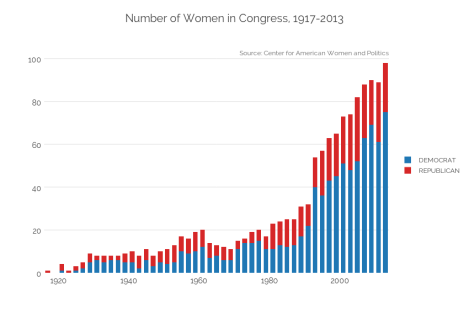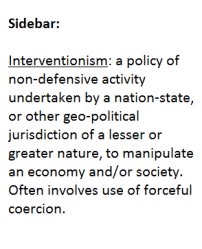In 1916, four years before the ratification of the 19th Amendment, Jeannette Rankin (from Montana) was the first woman to be elected to the House of Representatives. Six years later, in 1922, Rebecca Felton (from Georgia) became the first female member of the Senate. The number of women in Congress thus began its gradual increase. The following graph illustrates the number of women serving in Congress, from 1917 to 2013.


As the graph shows, the number of women in the House and Senate has increased fairly consistently since 1917 (with a spike in 1992—popularly labeled “the Year of the Woman” following the election of a number of female Senators). The graph also shows the party identification trends of the women in Congress; they tended to identify as Democrat rather than Republican, particularly beginning in the 90s.
Congress wields extensive power regarding foreign policy. The legislators shape foreign policy without direct contact with other nations, instead affecting relations through the laws they pass, and the treaties and nominations that they approve. So how has the increasing presence of women affected these processes?
Trend of Anti-Force?
A number of sources offer similar speculation about the way in which the female nature affects one’s view on methods of foreign relations. In general, women are viewed as having the tendency to take a more pacifist stance on war-related foreign policy; it is often speculated that their “maternal” nature allows for a more caring and anti-violence outlook. Stereotypically, women are considered to be more peaceful than men.
Statistically, the influence of this “ethic of care” regarding women in general appears to have some basis. In fact, the issue of force and violence appears the be the most statistically supported area in which men and women differ significantly. “Both with respect to domestic uses of force (for instance gun control and capital punishment) and international uses of force (for instance, defense and troop levels abroad) women tend to be, on average, consistently less willing to support force policies” (McGlen and Sarkees 1993, 190).
Women Against Foreign Intervention
This idea of women as being more likely to reject ideas of force and support more pacifist, peace-making types of policies appear to be supported, to a certain degree, by the decisions made by congresswomen. Female members of Congress tended to be more supportive of social welfare legislation, and less so towards defense spending and  interventionist foreign policy (Thomas 1994, 58). Out of 5,267 listed congressional bills relating to foreign intervention under the “Armed Forces and National Security” category, proposed between 1973 and 2015, fewer than 450 were sponsored by female members of Congress—about 8.3%.
interventionist foreign policy (Thomas 1994, 58). Out of 5,267 listed congressional bills relating to foreign intervention under the “Armed Forces and National Security” category, proposed between 1973 and 2015, fewer than 450 were sponsored by female members of Congress—about 8.3%.
In addition, of these 450 bills, a fairly large portion were regarding veteran care, social support, and peacekeeping. For example, Maine senator Olympia Snowe sponsored 43 of the bills falling under this category, regarding “Armed Forces and National Security” in relation to foreign intervention; however, several of these were International Peacekeeping Policy Acts for various years, as well as a number of bills regarding support for human rights, child support, and extending aid in foreign countries.
That is not to say that some women did not take a different stance on these subjects; House member Edna Flannery Kelly, serving from 1949 to 1969, was a member of the Foreign Affairs Committee, pushed for heavy foreign aid restrictions, including proposing amendments that required careful inspection and review before approving developmental loans (Engelbarts 1974, 64). However, it appeared that women who took this type of approach were in the relative minority among their peers. As opposed to supporting the interventionist style of foreign policy that prevailed during times of war in the United States, women in Congress, generally speaking, appeared to be against the uses of intervention, force, and violence in foreign policy.
So, Then Has Interventionism Declined as More Women Took Office?
In this very general sense, research shows that women tend to take the non-violent and non-interventionist approach to foreign policy in recent decades. However, since tendencies towards foreign interventionism rise regardless of some opposition during times of war, it is difficult to judge the level of impact that women’s general anti-force influences would have had. Nonetheless, based on the comparatively higher levels of anti-interventionist tendencies shown by women in Congress, it is easy to infer that the foreign policy legislation that went through Congress was at the very least less aggressive and less forceful than it might have been without them.